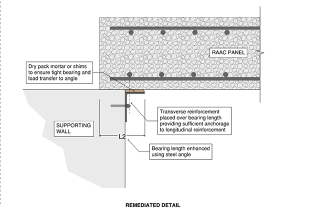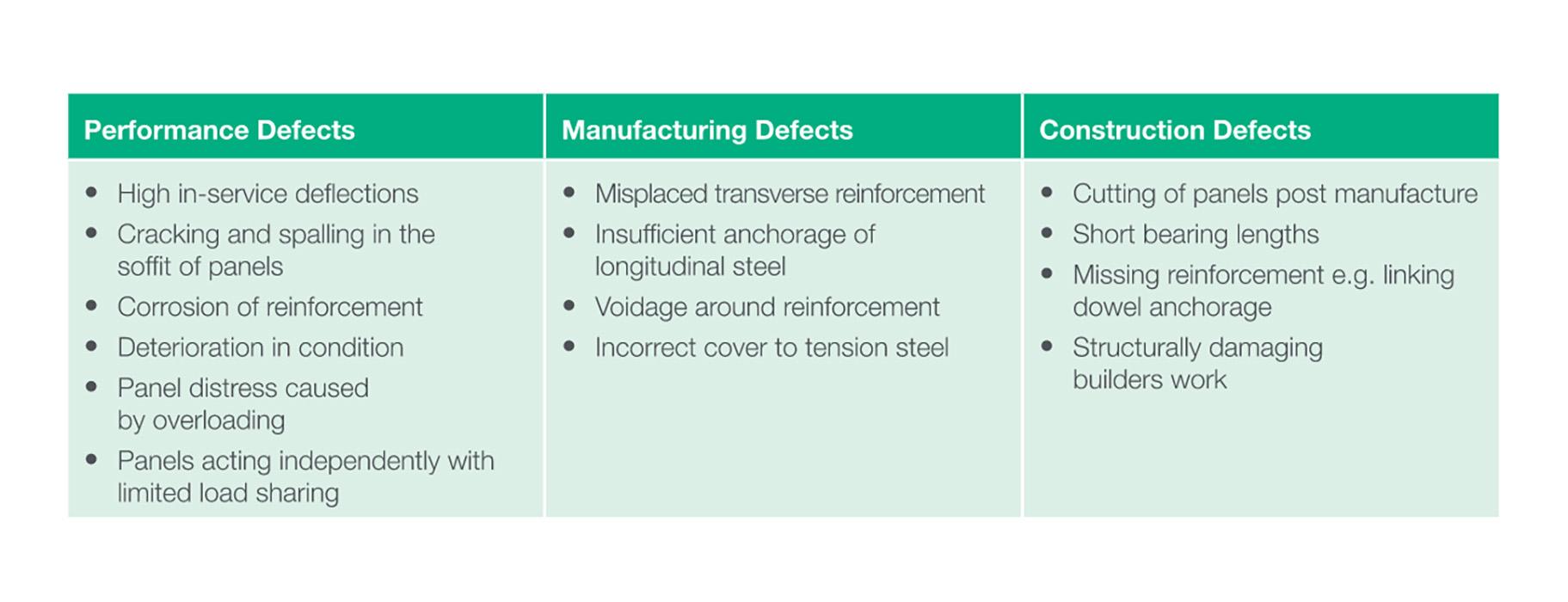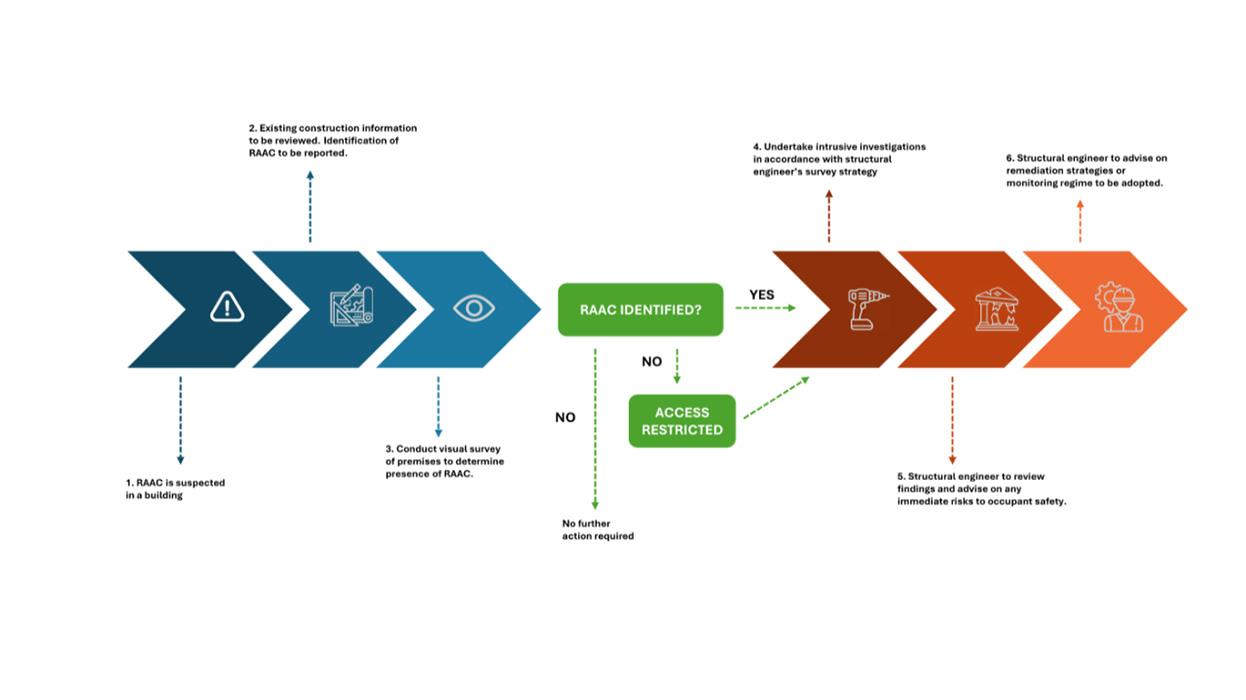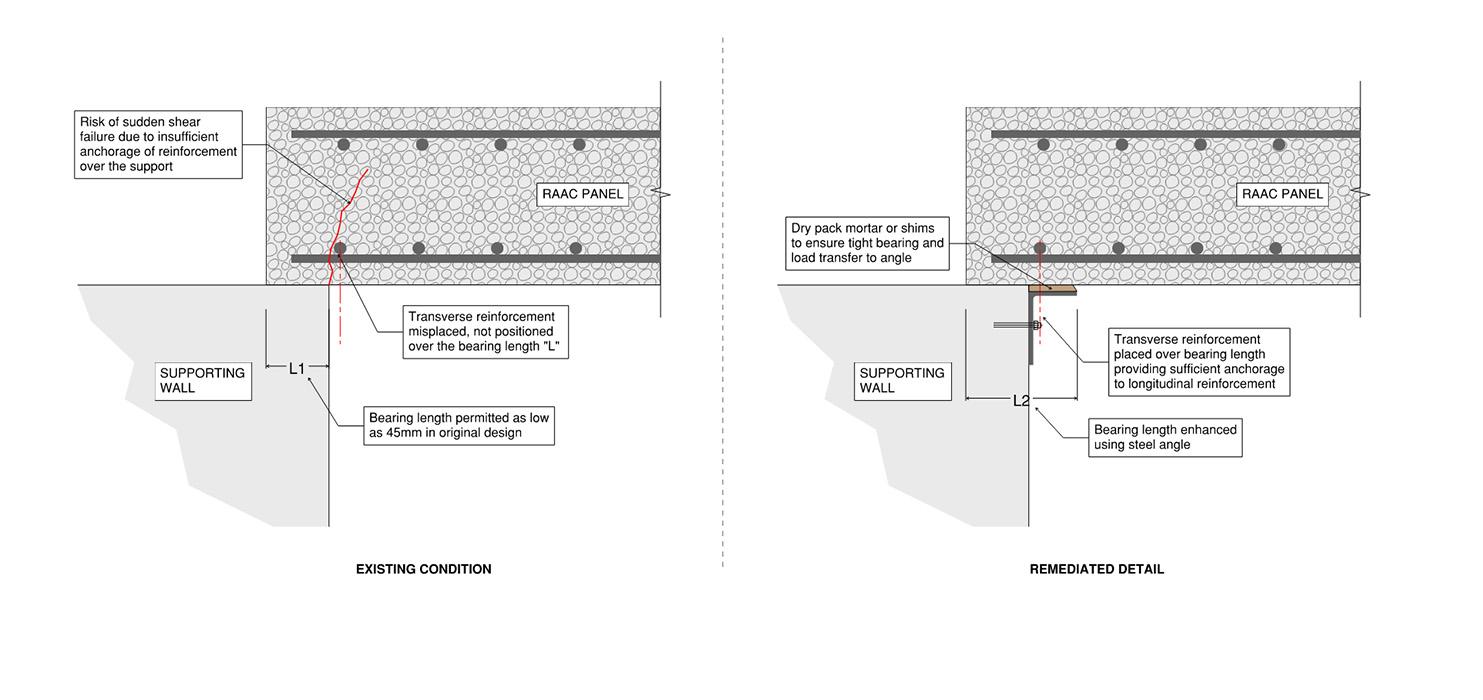News | Thought Leadership
An Update on RAAC in the UK
 Thornton Tomasetti
Thornton Tomasetti
Key Takeaways
- Ongoing RAAC Risks - Reinforced Autoclaved Aerated Concrete (RAAC), used in UK buildings from the 1950s to 1990s, has a 30-year lifespan and defects like weak reinforcement bonds and corrosion, increasing risks of structural failure.
- Concealed Defects - RAAC’s porous nature hides corrosion without visible signs like spalling, making detection difficult and raising the risk of sudden shear failure.
- AI in Assessments - Loughborough University’s AI tool, with 95% accuracy, detects RAAC defects like hairline cracks, improving efficiency in risk assessment and remediation planning.
- Management and Funding - As of October 2024, 237 UK schools have RAAC. NHS funding (£698m, 2021-2025) targets risk elimination by 2035, but slow progress necessitates ongoing monitoring and asset management.
Introduction
Although headline news on Reinforced Autoclaved Aerated Concrete (RAAC) has quietened in recent years, the persistent issues associated with this notorious construction material continue to present a painful legacy from the mid-1900s.
A CROSS UK (Collaborative Reporting on Safer Structures) report issued in June 2025 highlighted widespread RAAC defects concealed behind layers of paint on the soffit of a public library roof. This observation escalated the premises from an “amber” status to a “red-critical” safety risk. It serves as a stark reminder that defective RAAC structures remain deeply embedded in our aging building stock.
What Is RAAC
RAAC planks are formed using a concrete mix of fine aggregate (sand), cement, water and lime. The addition of aluminium powder reacts with the mixture to create air bubbles. The mix is poured into moulds and then cured under heat and pressure (autoclaved) to produce a usable construction material. The entrained air results in a lightweight alternative to traditional concrete, approximately 25-30% of its density. This porosity and reduced density significantly affect key material properties, including compressive, shear and tensile strengths, the quality of reinforcement bond and reduced durability.
RAAC has been used in the UK since the post-war period of the 1950s. High demand for fast and low-cost construction accelerated the adoption of alternative construction methods. RAAC’s insulating and fire-resistant properties, along with its adaptability for on-site modifications, made it an attractive option for the public sector. It was commonly used in roof and floor panels of public facilities such as schools and hospitals.
RAAC products have an expected lifespan of approximately 30 years, owing to their weaker nature compared to standard reinforced concrete, which is typically designed for a life span of 50–100 years. As a result, even the most recent installations in the mid-1990s have now exhausted their estimated service life.
Although RAAC continues to be produced and used globally, and it can perform successfully when designed and manufactured appropriately, the primary concern in the UK relates to material installed during the mid-1900s. In these cases, inconsistencies in manufacturing and installation have significantly increased the risk of structural failure.
History and Notoriety
Instances of RAAC failure have been documented since the 1980s, with case studies identifying recurring defects such as insufficient cover to embedded reinforcement and high span-to-depth ratios, leading to deflection issues. Common consequences of excessive deflection include cracking, spalling, ponding of rainwater and damage to waterproofing systems. These conditions can accelerate corrosion of steel reinforcement.
In late 2018, government bodies contacted all school building owners following the sudden collapse of RAAC roof panels at Singlewell Primary School in Gravesend.
RAAC subsequently received widespread media attention after a SCOSS (Standing Committee on Structural Safety) Alert was issued on 1st May 2019, titled “Failure of reinforced autoclaved aerated concrete (RAAC) planks”. This was followed in September 2022 by a ‘Safety Briefing Notice’ from the office of Government Property to all property leaders, warning that RAAC “is now life-expired and liable to collapse”.
Typical Defects and Modes of Failure
The Building Research Establishment (BRE) published papers in 1996 and 2002 in response to emerging structural deficiencies in RAAC products, as early installations from the 1950s approached the end of their service life. BRE Information Paper IP 10/96 outlines common defects, which have since been categorised by the Institution of Structural Engineers (IStructE) into the following groups:
One of the more interesting and insidious characteristics of RAAC is that corrosion of embedded reinforcement can sometimes remain concealed without the obvious spalling or external damage typically observed in traditional concrete. This occurs because the porous matrix and lower strength of RAAC tend to inhibit the localised cracking and cover delamination commonly associated with corrosion-induced spalling.
Another critical vulnerability lies in RAAC’s bond behaviour, particularly its load-sharing mechanism between the main reinforcement bars and the surrounding concrete. In traditional concrete, bond stresses at the material interface are relied upon to transfer forces. However, the voids in RAAC cause longitudinal bond issues, which are addressed by welded transverse bars. Ingress of water and subsequent corrosion can compromise these welds, weakening the panel’s ability to transfer load to the reinforcement.
Research and the Role of AI in RAAC Assessment
Loughborough University is the leading institution on academic research on RAAC. The NHS has funded research undertaken at the university focusing specifically on healthcare buildings. As a result, current research has been limited to this particular building type, leaving a gap in the investigation of other structures which may have been constructed differently.
The research has primarily focused on material properties and critical failure modes. Findings suggest that critical failures often stem from insufficient bearing length and misplaced transverse reinforcement at the supports.
To support this work, Loughborough University has developed a bespoke tool, trained on thousands of images of RAAC products, that can identify defects such as hairline cracks with the aim of understanding their impact on structural integrity and ultimately, residual lifespan. The university has reported an accuracy rate of 95%. This success has facilitated the tool’s adoption in the assessment process, leading to significant efficiencies in what is otherwise an extremely time-consuming and resource-intensive task.
AI tools have also been implemented by key insurers of at-risk properties to review policy wording and accelerate response time to policyholders. For example, AXA Commercial reported using these tools to review thousands of documents following school closures in August 2023.
Protocol for Inspection and Maintenance
The figure below outlines a typical approach a building owner may adopt when suspecting the presence of RAAC within their property. The choice of monitoring regime or remediation strategy depends on the existing condition of any identified RAAC.
As advised by the IStructE, an objective condition assessment requires detailed survey reporting on panel characteristics such as crack and delamination patterns, identified penetrations, debond hammer tap tests near supports and photographic records. This approach enables repeatable inspections from different operatives.
RAAC survey data should then be used to categorise the risk rating of planks using a RAG (red, amber, green) classification system:
- Red (Critical) requires immediate replacement or remediation, including propping and access restriction.
- Red (High risk) requires remediation as soon as possible, including an awareness campaign and reports of change of condition.
- Amber requires regular monitoring (6-12 months) with awareness campaign for occupants.
- Green requires occasional monitoring (3-5 years) with awareness campaign for occupants.
As a general rule a 5-year monitoring regime can be sufficient if the condition is sound, bearing lengths are adequate and deflections are less than 1/200th of the span length between supports. Further detailed information on risk categorisation is provided in IStructE Reinforced Autoclaved Aerated Concrete (RAAC) Panels Investigation and Assessment. Further Guidance 2023.
Remediation Strategies
Variations in manufacturing and construction tolerances can result in critical transverse reinforcement being misplaced over the bearing supports of panels, compromising reinforcement anchorage and increasing the risk of sudden shear failure. Enhancing the panel’s end-bearing using steel shelf angles can effectively mitigate this critical risk.
Replacement of individual panels with a lightweight alternative may be considered. However, the continuity of adjacent panels must be considered to avoid independent behaviour and ensure structural redundancy.
Repair mortars provide an effective method for patching local defects such as spalling. Nevertheless, the potential for local reinforcement corrosion must be carefully assessed. Extensive patch repairs may also face issues due to poor bonding between the repair mortar and the porous RAAC matrix.
The Status of RAAC in 2025
The IStructE formed an active Study Group on RAAC following the 2018 collapse. This group remains active in developing and sharing guidance around identification, management and remediation. UK Concrete and the Mineral Products Association (MPA) are also currently sharing expertise and providing guidance to the Construction Leadership Council’s (CLC) RAAC Industry Response Group.
The latest figures published by the government (Oct 2024) state that 237 state-funded education facilities have identified RAAC, representing roughly 1% of schools and colleges. Schools that were temporarily closed following the incident in 2018 have since reopened with full-time, face-to-face education. The associated risks must be managed through incremental inspection and remediation regimes that eliminate the risk of collapse until funding is available for replacement or rebuilding.
Regarding funding for the NHS estate, Department of Health and Social Care (DHSC) pledged £698m between 2021-2025 with the aim of eradicating RAAC-related safety risk by 2035. However, remediation progress is slow, and, therefore, the adoption of well-structured monitoring regimes will likely remain a key practice in the short term.
Periodic updates from the research conducted by Loughborough University are expected as new findings become available. The research not only explores the scientific aspects of RAAC but also focuses on practical methods for integrating survey data into an asset management system, similar to the golden thread requirements of the Building Safety Act. The ultimate goal is to establish a managed, risk-based system that enables us to live with RAAC safely in the medium to long term.
The legacy of RAAC is a reminder of the importance of rigorous standards and the ongoing need to adapt and innovate in construction and maintenance practices. While much progress has been made, it remains clear that this issue requires continued vigilance, research and proactive long-term asset management.
Reading List
- SCOSS Failure of RAAC planks
- LGA information on RAAC
- Loughborough University
- Commons library research briefing; RAAC in the UK: Concerns and government response 10th Jan 2024
- IStructE RAAC Panels Investigation and Assessment. Feb 2022
- MPA UK Concrete RAAC factsheet Q&A
- RCS (RAAC Consulting and Solutions)
- BRE IP 10/96 RAAC planks designed before 1980
- IStructE RAAC Panels Investigation and Assessment. Further Guidance 2023
Authored By




